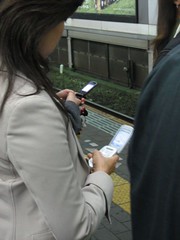 I’m surprised more people haven’t seen the insight in Nikhyl Singhal’s post. Back in August of 2010, he wrote the controversial post “Phone Numbers Are Dead, They Just Don’t Know It Yet” on TechCrunch. I say “controversial” because most of the commenters attacked his article. Not that TechCrunch’s comments are really that intelligent; sometimes far from it. The overwhelming criticism was still startling though.
I’m surprised more people haven’t seen the insight in Nikhyl Singhal’s post. Back in August of 2010, he wrote the controversial post “Phone Numbers Are Dead, They Just Don’t Know It Yet” on TechCrunch. I say “controversial” because most of the commenters attacked his article. Not that TechCrunch’s comments are really that intelligent; sometimes far from it. The overwhelming criticism was still startling though.
In his article, Singhal asserts that phone numbers will go away because of these facts:
-
No control. Anyone can dial your 10 digits, including your ex-girlfriend, a political campaign worker, or a solicitor. Unlisted numbers, Caller ID and do-not-call lists all tried to solve this problem, but these solutions still don’t prevent unwanted calls.
-
Phone numbers are tied to a device, not to you. Everyone has multiple numbers, yet your home line is shared, leaving callers guessing the best way to reach you.
-
User experience is very limited. The phone was designed as a utility—dial a number, have a conversation. It’s remained this way since its inception. It’s not optimized for other experiences, which is why voicemail and conference calls are tedious, and why checking flight status is worse than a root canal.
He sees them being replaced with social networks such as Facebook. “If given a choice between Ma Bell and Zuckerbell as our operator, we should choose Zuck,” he writes.
Perhaps he came across too “sensationalistic” as one commenter criticized. Though I agree with Singhal’s prediction, I would frame it differently. Here is the core reason why I believe phone numbers will lose their utility:
Phone numbers are a poor unique identifier
This seemingly random string of numbers is meant to represent you – or specifically, one of your devices, as Singhal points out. It is a holdover from the telecommunications industry and is a viable solution if you:
- only need to call a handful of people often
- those people don’t change their numbers often
The cognitive load of a handful of numbers is adequate for some people. However, many people need to be in contact with a wider number. And many change their numbers several times in their lifetime.
If you’ve ever kept a manual phonebook, you’ll know what I’m talking about. Ever try calling an old friend, only to discover their number has been disconnected? That’s what I mean.
I don’t know if Facebook is the appropriate solution, but conceptually, there is a definite need for a way to uniquely identify a person, so he/she can be contacted by friends easily. What are some other ways to uniquely identify a person?
Unique identifier alternatives
There are quite a few ways to uniquely identify a person:
- Real name
- Username
- Email address
- OpenID
- Social security number
- Driver’s license
- Passport
- License plate number
- Fingerprints
- DNA
Real name
A name is the simplest real-world identifier. That’s how you identify your friends & family in a crowded room. There’s more here too, which I’ll get to after I go over the others.
Username & email address
Usernames & email addresses are both are common in the Internet. They are used on social media sites, community forums, instant messengers, etc. They are not a great solution, however, because they have limited namespaces.
For instance, there can only be one person who uses the username “mikelee.” This leads to usernames like “mikelee13” and “mikelee2010.” The meaningfulness of “mikelee12345” is small. Did you mean to contact “mikelee12345” or “mikelee12346?” Same goes for email addresses too.
And, for phone numbers as well. New area codes are created all the time to address the growing population, but conceivably, we will run out of available numbers one day. That’s a huge, obvious problem, if you ask me.
Usernames & email addresses have the benefit of nearly unlimited lengths, while phone numbers are limited. That’s a slight advantage with the former two, but because it’s easier to remember shorter identifiers, namespace conflicts still exist. Long identifiers aren’t just more difficult to remember, they are more difficult to display too. Imagine trying to display “mikelee-from-newyork-now-in-sanfrancisco” on your communications device. Jeepers.
OpenID
OpenID is a technical protocol that is used in user authentication. It’s more for an individual to log into a website, than for you to contact and connect with that individual. So it wouldn’t help in this context.
Social security number
This number is a little too important to be used casually. As a government-issued unique identifier, it can lead to identity fraud if used maliciously.
It’s arguably a poor unique identifier as well. I would love to see the government use a different one. But there are few viable alternatives for them. Facebook sure wouldn’t work. Maybe something biological? I don’t know. That’s a tougher problem to solve.
Driver’s license & passport
Being physical items, it would be difficult to use these in a communications context. Their numbers – which are really alphanumeric – are more portable than the physical items themselves. Being of a limited length, these numbers suffer from namespace issues as well, though the use of alphabetic characters extends them a bit.
But who’s realistically going to memorize or write down their friends’ driver’s license and/or passport numbers? They aren’t even as good as usernames and email addresses. People can select their own usernames & email addresses; driver’s license & passport numbers are issued seemingly at random.
License plate number
I included this one just to highlight its absurdity. A license plate number is a unique identifier for a vehicle, not a person. It’s about as helpful as a phone number, which is really a unique identifier for a mobile device, not a person. The only difference is portability; it’s easier to bring a mobile device with you than, well, a vehicle.
Fingerprints & DNA
There are a whole host of biometric unique identifiers, from physiological (fingerprints, DNA, retinal patterns) to behavioral (voice, gait, typing rhythm). Sure, these can uniquely identify a friend, but how would you realistically use a friend’s retinal pattern to send them a message? Keep a copy of your friend’s eyeball on your keychain? Gross.
Ideal unique identification traits
Obviously, most of the unique identifiers listed above wouldn’t work in a communication context. What would work? The perfect identifier would be:
- Unique
- Meaningful
- Scalable
- Portable
It’s got to be unique, of course.
It should also be meaningful. “mikelee12345” isn’t terribly meaningful, but it’s possible to achieve some kind of meaning in such an alphanumeric string. “mikelee-from-newyork” perhaps? Long and unwieldy, but more meaningful.
It should be scalable. Limited-length strings have a, you know, limit. The only way to scale those is to increase the limit – which has its pitfalls (the constraints of limits, I mean). Think Y2K. Someday, we’ll have a Y10K problem.
It should be portable. Some unique identifiers, like physical items and biometrics, aren’t portable. That’s why alphanumeric strings have been used in the past. It’s easy to store such an identifier in a communications device.
With these limitations, it’s easy to see why phone numbers and usernames have been in use. But is there a better way?
Contextual real-world unique identification
I briefly touched on how real names are the simplest real-world identifier. In a crowded room, you can use a person’s first name to identify him/her. For a common name like “Mike,” a last name is necessary. And for a common name like “Mike Lee,” you need to add an extra layer of context, because by themselves, real names aren’t unique enough.
What is a useful layer of context? There are several kinds. You can say, “Mike Lee from New York,” “Mike Lee, who used to work at Yahoo,” or “Mike Lee, that hairy Chinese American guy.” Current location and hometown are common contextual items. Vocation and employment is another, especially in the US. A physical or personality-based description is another.
Some social networks realize this. LinkedIn uses a real name, photo, current employment, and a self-chosen tagline. Facebook uses a real name, photo and a network. On a mobile device, both default to the simplest pair: a real name & a photo.
That, to me, is the key. A real name & a photo. The real name is a natural identifier, and the photo adds context. Together, these are unique, meaningful, scalable (a photo is rich visual representation with a nearly infinite set of pixel combinations), and portal (a photo image file is also small enough to be stored on a mobile device).
Phone numbers vs real names & photos
I consider myself a humanistic technologist. I believe that technology should be centered around the interests, needs, and behavior of human beings. Technology is a tool and shouldn’t be a hinderance, as it often is.
This is what Singhal was trying to convey. Phone numbers surface technical constraints. They are an unnatural way to reach your friends. We’ve put up with it because realistic alternatives haven’t existed. The advent of social networks and mobile devices may finally be offering a viable solution.
Within the code of a LinkedIn or Facebook account, each individual is represented by a numeric (or perhaps alphanumeric) unique identifier. And that’s okay. That’s how programming languages can most efficiently handle a unique entity. But the presentation of that information should not reflect technology’s constraints. It should reflect your actual mental mode of that individual. Such as a real name & a photo.
 Social engineering is the act of manipulating people into performing actions or divulging confidential information. It is usually committed using technology.
Social engineering is the act of manipulating people into performing actions or divulging confidential information. It is usually committed using technology., an Internet connection, a little ingenuity, a lot of time, and an insidious motive could craft a social media scam nowadays. People are falling for them all the time.



 Now for some Friday fun.
Now for some Friday fun. It’s being referred to enough by the media that I think it will become a commonly-known adage. Facebook founder Mark Zuckerberg’s Law, I mean. And I don’t mean the “
It’s being referred to enough by the media that I think it will become a commonly-known adage. Facebook founder Mark Zuckerberg’s Law, I mean. And I don’t mean the “